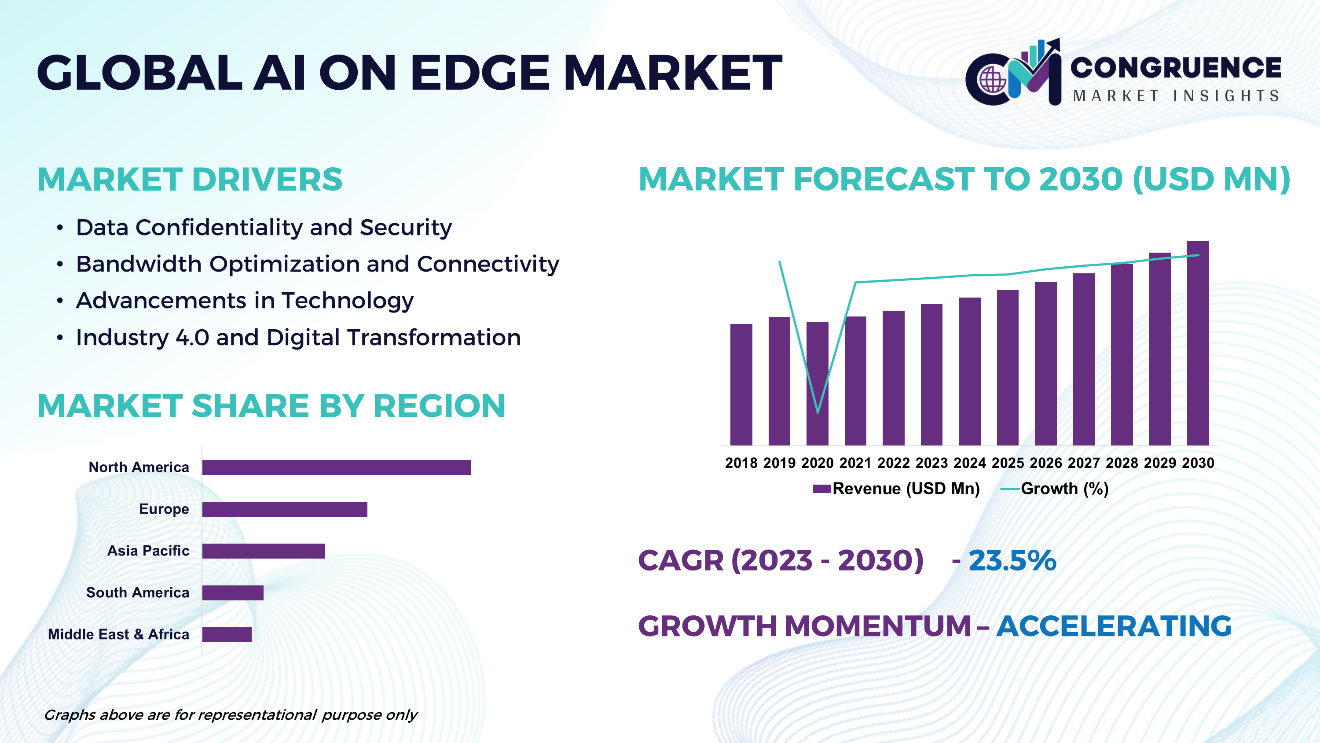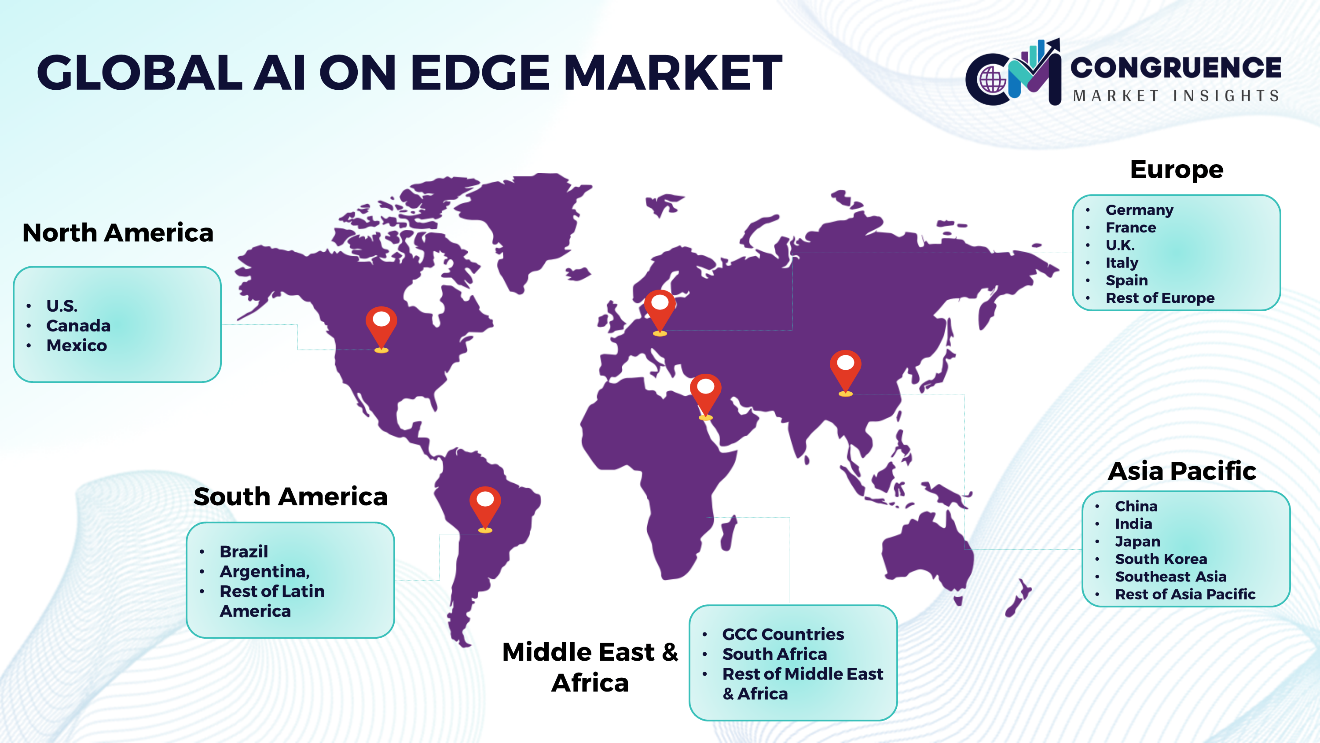Reports
The Global AI on Edge Market is expected to expand at a CAGR of 23.5% between 2023 and 2030. AI on the edge epitomizes a transformative paradigm shift whereby artificial intelligence (AI) algorithms find direct deployment on edge devices, thereby revolutionizing industries comprehensively. Through integration with network technologies such as 5G, IoT, and IIoT, AI on the edge facilitates real-time data processing and analysis, thereby augmenting industry performance by enabling predictive maintenance, process optimization, and superior decision-making. Additionally, the incorporation of AR and VR technologies, seamlessly fused with AI, furnishes immersive experiences and heightened insights. The market landscape for AI on the edge is notably dynamic, characterized by leading companies pioneering advancements in hardware, software, and integrated solutions to meet the escalating demand for intelligent edge computing capabilities.

AI on Edge Market Major Driving Forces
Data Confidentiality and Security: Edge computing ensures that sensitive data remains localized, diminishing the necessity for transmitting data to centralized servers. Consequently, this bolsters data confidentiality and security, addressing concerns pertaining to data breaches and compliance with regulatory frameworks like GDPR.
Bandwidth Optimization and Connectivity: By processing data at the local level, AI on Edge minimizes the volume of data requiring transmission over networks. This alleviates bandwidth constraints and network congestion, particularly in settings with limited connectivity or high network latency.
Advancements in Technology: The proliferation of technologies like 5G, IoT, and edge devices has expedited the adoption of AI on Edge. These technological advancements serve as the bedrock for deploying AI models at the network edge, thereby fostering novel use cases and applications across various industries.
Industry 4.0 and Digital Transformation: AI on Edge assumes a pivotal role in Industry 4.0 initiatives and digital transformation endeavors across diverse sectors. By facilitating intelligent automation, predictive analytics, and real-time monitoring, it drives efficiency, productivity, and innovation in realms such as manufacturing, logistics, and energy.
AI on Edge Market Key Opportunities
Edge AI for IoT Devices: The proliferation of IoT devices creates opportunities for deploying AI algorithms directly on these devices, enabling intelligent decision-making at the edge and unlocking new use cases in smart homes, industrial IoT, and environmental monitoring.
Edge AI in Retail: Edge computing combined with AI can revolutionize the retail industry by enabling personalized shopping experiences, real-time inventory management, and cashier-less stores, presenting opportunities for retailers to enhance customer engagement and streamline operations.
Edge AI in Smart Cities: Edge computing and AI technologies can optimize resource allocation, enhance public safety, and improve urban planning in smart city initiatives, creating opportunities for technology providers, governments, and urban planners to create more efficient and sustainable cities.
Edge AI in Agriculture: AI on Edge can be used to analyze data from sensors and drones to optimize crop yields, monitor soil conditions, and detect crop diseases, presenting opportunities for precision agriculture and sustainable farming practices.
AI on Edge Market Key Trends
· The increasing adoption of IoT devices and sensors fuels the expansion of edge computing, creating a robust ecosystem for AI on Edge applications.
· Ongoing progress in AI algorithms, particularly in deep learning and reinforcement learning, empowers the deployment of sophisticated models on edge devices with limited computational resources.
· Integration of edge computing with cloud services leads to hybrid architectures, leveraging the strengths of both for AI processing and data management.
· Specialized AI chipsets optimized for edge tasks enhance performance and efficiency, enabling complex AI models to run effectively on edge devices.
· Growing concerns about data privacy prompt the development of techniques allowing local processing of sensitive data on edge devices without compromising privacy.
· Industry standards and protocols facilitate interoperability between edge devices, enabling seamless integration with existing infrastructure.
· Analysis of data at the edge enables intelligent decisions about data transmission, reducing bandwidth usage and latency.
· Preprocessing data at the edge filters irrelevant information before transmitting essential data to the cloud, decreasing bandwidth costs and improving system efficiency.

Market Competition Landscape
In the competitive landscape, companies vie for market dominance through strategic differentiation. Key factors include technological innovation, product performance, pricing strategies, and customer service. Market leaders focus on enhancing brand equity and expanding market reach through partnerships and acquisitions. Agility and adaptability to evolving market trends are crucial for sustaining competitiveness in this dynamic landscape.
Key players in the global AI on Edge market implement various organic and inorganic strategies to strengthen and improve their market positioning. Prominent players in the market include:
· NVIDIA Corporation
· Intel Corporation
· Qualcomm Technologies, Inc.
· IBM Corporation
· Google LLC
· Microsoft Corporation
· Samsung Electronics Co., Ltd.
· Amazon Web Services, Inc.
· Huawei Technologies Co., Ltd.
· Apple Inc.
· Xilinx, Inc.
· MediaTek Inc.
· Texas Instruments Incorporated
· Advanced Micro Devices, Inc. (AMD)
· Synopsys, Inc.
· Infineon Technologies AG
· NXP Semiconductors N.V.
· Analog Devices, Inc.
· Renesas Electronics Corporation
|
Report Attribute/Metric |
Details |
|
Base Year |
2022 |
|
Forecast Period |
2023 – 2030 |
|
Historical Data |
2018 to 2022 |
|
Forecast Unit |
Value (US$ Mn) |
|
Key Report Deliverable |
Revenue Forecast, Growth Trends, Market Dynamics, Segmental Overview, Regional and Country-wise Analysis, Competition Landscape |
|
Segments Covered |
· By Offering (Hardware (Processors, Memory Unit, Sensors, Connectivity Modules, and Others), Software) · By Deployment Model (On-premises, and Cloud-based) · By Application (Smart Security and Surveillance, Industrial IoT (IIoT), Navigation and Collision Tracking, Remote Patient Monitoring, Image and Video Processing, Traffic Management, and Others) · By End Use Industry (Healthcare, Manufacturing, Retail, Transportation and Logistics, Agriculture, Energy and Utilities, and Others) |
|
Geographies Covered |
North America: U.S., Canada and Mexico Europe: Germany, France, U.K., Italy, Spain, and Rest of Europe Asia Pacific: China, India, Japan, South Korea, Southeast Asia, and Rest of Asia Pacific South America: Brazil, Argentina, and Rest of Latin America Middle East & Africa: GCC Countries, South Africa, and Rest of Middle East & Africa |
|
Key Players Analyzed |
NVIDIA Corporation, Intel Corporation, Qualcomm Technologies, Inc., IBM Corporation, Google LLC, Microsoft Corporation, Samsung Electronics Co., Ltd., Amazon Web Services, Inc., Huawei Technologies Co., Ltd., Apple Inc., Xilinx, Inc., MediaTek Inc., Texas Instruments Incorporated, Advanced Micro Devices, Inc. (AMD), Synopsys, Inc., Infineon Technologies AG, NXP Semiconductors N.V., Analog Devices, Inc., and Renesas Electronics Corporation |
|
Customization & Pricing |
Available on Request (10% Customization is Free) |
